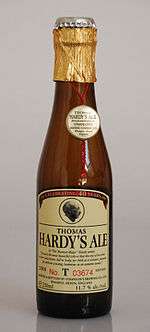Old ale
Old ale is a term commonly applied to dark, malty beers in England, generally above 5% ABV, also to dark ales of any strength in Australia.[1] It is sometimes associated with stock ale or, archaically, keeping ale, in which the beer is held at the brewery.
.jpg)
History
Historically, old ales served as a complement to mild ales, and in pubs of the era typically the landlord would serve the customer a blend of the sharper stock ale with the fruitier, sweeter mild ale to the customer's taste. In London especially, the aged ale would take on a tart note from a secondary fermentation with brettanomyces yeast which was present either in the pitching yeast or in the wooden equipment.[2] Because of the time required for the aging process, some investors would buy mild ale from brewers, age it into old ale, and sell it at the higher price. Eventually, brewers began to keep some beer behind at the brewery, age it themselves and sell it to the pubs. In some cases old ale was a blend of young and old. The "stock ale" was the brewery's very aged ale and was used to inject an "old" quality, and perhaps acidity to the blend.
Burton Ale
In London especially, Burton was a synonym for old ale.[3]
Winter warmer
A winter warmer is a traditional malty-sweet strong ale that is brewed in the winter months. It is usually quite dark, but not as dark as a stout, with a big malt presence. Sometimes, winter warmers have a few spices, especially in the United States, although spices are not a required ingredient in a winter warmer. The primary characteristic is strength: the average alcohol content by volume ranges from 6.0% to 8.0% ABV and some winter warmers reach 10% ABV or more. Christmas beer is another type of winter warmer, similarly strong in alcohol content and usually spiced. The United Kingdom is most commonly associated with the term "winter warmer", whereas the United States mostly refers to them as a Christmas or Holiday beer.[4]
Variations

Some brewers will make a strong old ale for bottling. Some of these can mature for several years after bottling, and may or may not be bottle-conditioned.
The "October" keeping ales are thought to have formed the basis for India pale ales shipped by the British East India Company.
Another historic version was so-called "majority ale", a strong ale brewed on or around the birth of a child, and intended to be drunk on the child's twenty-first birthday.[5]
Some old ales blended older vintages with fresh beer in vats, on the solera system. Burton Ale brewed by the Ballantine brewery (Newark, New Jersey) was such a beer, and kept in production as a gift item for distributors and VIPs up until the closing of the brewery in 1972. The only surviving representatives are Greene King 5X and The Bruery's anniversary ales. Sour old ales fermented with Brettanomyces yeast were popular in 19th-century Britain. The style is now associated more with Belgian brewing, for instance Oud bruin and Rodenbach Grand Cru, although there is one surviving British example, Gales Prize Old Ale.[6]
A number of breweries, particularly in Sussex, produce a weaker style of old ale with some resemblance to a mild ale.[note 1] Examples include King and Barnes (later W. J King) (4.5% ABV) and Harveys (4.3% ABV) These are typically consumed on draught dispense.
Examples
Examples of old ales include:
- Theakston: Old Peculier[6]
- Robinsons Old Tom[6]
- Adnams Tally Ho[6]
- Adnams Old Ale[7]
- Fuller's: Vintage Ale
- Fuller's: Golden Pride
- Greene King: Olde Suffolk English Ale
- North Coast Brewing Company: Old Stock Ale
- Brooklyn Brewery: Blunderbuss Old Ale
- Full Sail: Wassail
- Smuttynose: Really Old Brown Dog
- Bell's Brewery: Third Coast Old Ale
- Founders Brewing Company: Old Curmudgeon
- Yazoo Brewing Company: Indomitus Dolium
- Adroit Theory Brewing Company: Love of the Damned
- Joseph Holt's Brewery: Sixex
- Saint Arnold Brewing Company: Christmas Ale
- Great Divide Brewing Company: Hibernation Ale
- Miller Brewing Company: Olde English 800
- Brauerei Sutton: Butcher's Brown Ale
Notes
- The boundary between old ale and mild is blurry, simply because, historically, old ale was mild ale, but aged.[6]
References
- "Michael Jackson's Beer Hunter - Beer Styles: Old (Ale)". Beerhunter.com. Retrieved 2011-06-26.
- Lloyd Hind, H (1940). Brewing Science and Practice: Volume II Brewing Processes. London. pp. 800–802.
- Martyn Cornell, Amber, Gold and Black, p. 44
- "Winter Beer Styles - Christmas Beer | Beer of the Month Club". The Microbrewed Beer of the Month Club. Retrieved 2018-06-24.
- Dr John Harrison (2003). Old British Beers and How To Make Them. Durden Park Beer Circle. ISBN 978-0-9517752-1-9.
- Cornell, Martyn (22 May 2012). "Endangered Beers". Retrieved 7 August 2014.
- Fitzgerald, Fergus (2 November 2011). "Adnams Old Ale 4.1% abv available now". Retrieved 7 August 2014.
Bibliography
- Wheeler, Graham, and Roger Protz, Brew Your Own British Real Ale at Home. 1998, 2001, CAMRA Ltd. ISBN 1-85249-138-8
External links
| Wikimedia Commons has media related to Old ale. |